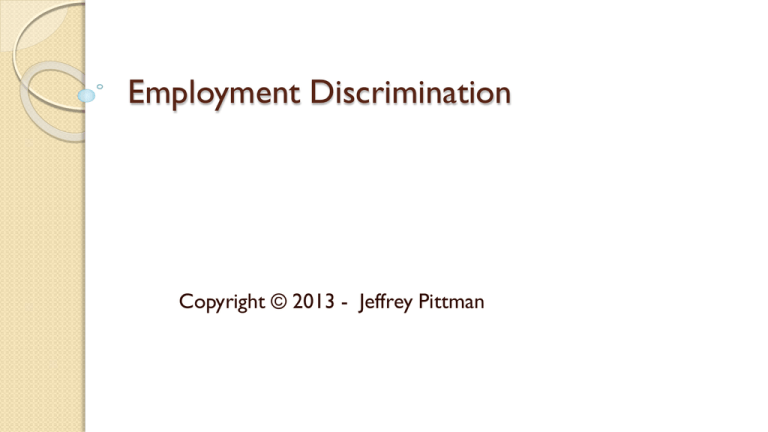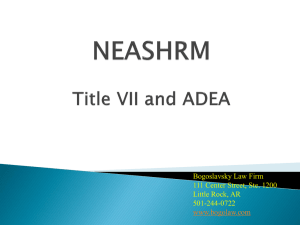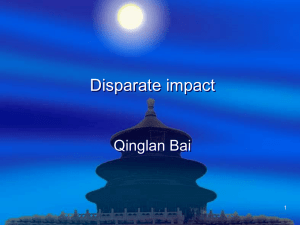
Employment Discrimination
Copyright © 2013 - Jeffrey Pittman
The Heart of an Organization
The keys to success for any company – the
employees
Jeffrey Pittman - Employment Law for
Business
2
Employment Lifecycle
An employee is:
Hired by the employer
Works for the employer
Leaves the employer
◦ Voluntarily
◦ Involuntarily - fired
Jeffrey Pittman - Employment Law for
Business
3
Wrongful Discharge
Being fired from a job is a legally and emotionally
significant event
An employee who wishes to challenge losing his/her job
does so with a wrongful discharge lawsuit
Wrongful discharge lawsuits outnumber failure to hire
lawsuits approximately 4 to 1, in the Unites States
Jeffrey Pittman - Employment Law for
Business
4
The Employment Relationship
Employment at will (EAW)
EAW is a doctrine which provides that a
contract of employment for an indefinite
term is terminable at the will of either
party
Under EAW, an at-will employee may be
discharged for good cause, no cause, or
even a morally wrong cause
Jeffrey Pittman - Employment Law for
Business
5
Ending the Employment Relationship
Federal exceptions to employment at will
Federal civil rights laws create a major
modification to employment at will
◦ Civil rights protections exist against discharge based
on age, race, gender, disability, religion, national origin,
or color
Jeffrey Pittman - Employment Law for
Business
6
Federal Civil Rights Protected Characteristics
Color
Age
Race
Disability
Origin
Religion
Sex
Jeffrey Pittman - Employment Law for
Business
7
Ending the Employment
Relationship
State exceptions to employment at will
State law also limits employment at will by requiring
employers to follow any contractual
commitments entered into, and by not allowing
employee firings that violate fundamental public
policy
Jeffrey Pittman - Employment Law for
Business
8
Major Federal Civil Rights
Legislation
The Equal Pay Act of 1963 (EPA), which protects men
and women who perform substantially equal work in
the same establishment from sex-based wage
discrimination
Jeffrey Pittman - Employment Law for
Business
9
Major Federal Civil Rights
Legislation
Title VII of the Civil Rights Act of 1964 (Title VII)
prohibits employment discrimination based on race,
color, religion, sex, or national origin
Jeffrey Pittman - Employment Law for
Business
10
Major Federal Civil Rights
Legislation
The Age Discrimination in Employment Act of 1967
(ADEA) protects individuals who are 40 years of age or
older
Jeffrey Pittman - Employment Law for
Business
11
Major Federal Civil Rights
Legislation
The Americans with Disabilities Act (ADA) prohibits
employment discrimination against qualified individuals
with disabilities
Jeffrey Pittman - Employment Law for
Business
12
Possible Civil Rights Violations
Failure to hire
Termination
Denial of promotion
Undesirable reassignment
Awards
Leave decisions
Compensation
Benefits
Training
Retaliation
Referral practices
Jeffrey Pittman - Employment Law for
Business
13
The EEOC
The U.S. Equal Employment Opportunity Commission
(EEOC) is the primary government agency charged with
enforcement of federal civil rights laws
Jeffrey Pittman - Employment Law for
Business
14
Disparate Treatment
The simplest form of illegal discrimination is disparate
treatment.
A basic question to test for disparate treatment is this:
Would the employment decision in question change if the
employee’s race, color, religion, national origin, sex, age, or
disability was different?
Jeffrey Pittman - Employment Law for
Business
15
Prima Facie Discrimination
A prima facie case is a presumption that discrimination
did take place, if logically possible
The presumption of discrimination disappears after the
plaintiff has completed the discovery process
Jeffrey Pittman - Employment Law for
Business
16
Proving Discrimination
Disparate Treatment
Evidence at Trial
Employee proves, with a
preponderance of the
evidence, discrimination
based on CAR DORS, or
Employee loses
If Employee is successful,
Employer must prove
discrimination is a BFOQ, or
Employer loses
Prima Facie
(Shifting the burden of proof)
Employee establishes prima facie evidence
of discrimination based on CAR DORS, or
Employee loses
Employer counters with legitimate
reasons for the action taken
Employee argues Employer’s reasons
are a pretext for discrimination
After discovery, the case proceeds
following “Evidence at Trial” column (unless
one party has failed to raise genuine issues
of material facts, leading to summary
judgment)
Jeffrey Pittman - Employment Law for
Business
17
Disparate Impact
Also labeled unintentional discrimination, disparate
impact violations of the law may come about through
inadvertent error on the part of the employer
The basic component of disparate impact is proof that
some employment practice, policy, or decision affects one
class of employee more harshly than it affects another class
Jeffrey Pittman - Employment Law for
Business
18
Proving Discrimination
Disparate Impact
Employee proves a “neutral” employment practice has an
adverse impact on a protected class, or Employee loses. If
successful,
Employer proves employment practice is job-related and
a business necessity, or Employer loses. If successful,
Employee counters that there is a less restrictive
alternate employment practice
Jeffrey Pittman - Employment Law for
Business
19
Sexual Harassment Theories
Sexual harassment involves unwelcome sexual advances or
other harassing conduct directed toward an employee
because of that employee’s gender, and
Quid Pro Quo
A supervisor conditions
a term of employment
upon agreeing to sexual
advances
Hostile Environment
The harassing conduct is
sufficiently severe or
pervasive as to 1) create an
intimidating or offensive
working environment or 2)
unreasonably interfere with
job performance
Jeffrey Pittman - Employment Law for
Business
20
Employer Liability for Sexual
Harassment
Employer liability for gender harassment by coemployees or customers. Employers are liable for
gender harassment directed at an employee from coemployees or customers where the employer’s agents
or supervisory employees know or should know
about the harassment, and fail to take immediate and
appropriate corrective action.
Jeffrey Pittman - Employment Law for
Business
21
Employer Liability for Sexual
Harassment
Employer liability for gender harassment by
supervisory employees - An employer has automatic
liability for gender harassment directed at an employee
if the harassment comes from a supervisor with
immediate (or higher) authority over the victimized
employee.
Jeffrey Pittman - Employment Law for
Business
22
Affirmative Defense
The employer may be released from this automatic
liability only if the employer can prove all three
elements of the following affirmative defense:
◦ 1. No tangible employment actions were taken against the
victimized employee, and
◦ 2. The employer exercised reasonable care to prevent
and correct promptly any harassing behavior, and
◦ 3. The employee unreasonably failed to take advantage
of any preventive or corrective opportunities provided by
the employer.
Jeffrey Pittman - Employment Law for Business
23
Affirmative Action Analysis
(Re: Plans Based on Race)
Government Plans - Equal
Protection from the US
Constitution requires:
◦ The affirmative action plan
must be narrowly tailored
to meet the objective, and
◦ There must be a
compelling state interest
for the plan (usually
meaning that there must
be past discrimination by
the entity involved)
Private Plans - Requirements
under the 1964 CRA:
◦ Plan must be based on past
discrimination or other
persuasive rationale, and
◦ There is no unnecessary
“trammeling” of rights, e.g.,
No firing, layoffs, or hiring
quota limits for nonminority
workers, and
The plan is temporary
Jeffrey Pittman - Employment Law for
Business
24








